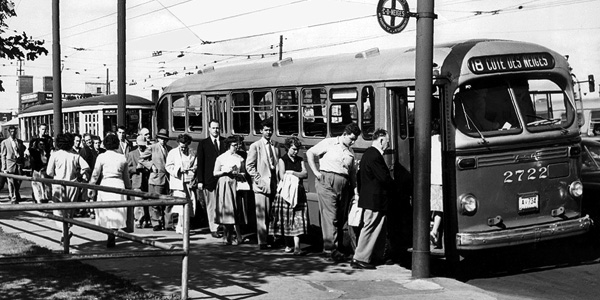
Canadian Car-Brill bus and tramway on Jean-Talon Street (1953)
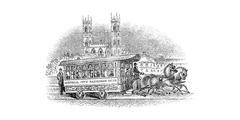
1861.05.18 Creation of the Montreal City Passenger Railway Company, first public transit company in Montréal
1861.09.18 Construction of the tramway network begins
1861.11.27 First tramway line put into service on today’s Notre-Dame Street
1864.06.10 Tramway lines put into service on St. Catherine Street and St. Lawrence Boulevard
1865.06.13 The company no longer allows drivers to stop and wait for passengers who stepped off to run an errand
1866.05.16 One-day strike by motormen and stable men, the first strike in the history of public transit in Montreal
1872.10.17 Tramway service cancelled because of a horse flu epidemic
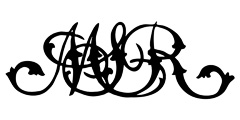
1886.06.21 The Montreal City Passenger Railway Company becomes the Montreal Street Railway Company
1892.09.21 The Rocket, first electric tramway put into service
1894.02.06 Transfer tickets put to the test
1894.10.27 Tramway network entirely powered by electricity
1898.09.16 Fire at Hochelaga tramway sheds
1900.07 Longer, more spacious, double truck tramways put into service
1901.08.06 The suburban network of the Park & Island Railway Company is bought by the Montreal Street Railway Company
1903.10.01 Creation of the Montreal Street Railway Company’s Mutual Benefit Association
1905.05.04 Inauguration of the Pay As You Enter (PAYE) tramway, the first public transit vehicle in which passengers pay when they board
1905.06 First observation tramway put into service
1907.07.01 The Montreal Street Railway Company takes over the suburban network of the Montreal Terminal Railway Company
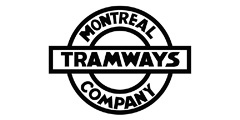
1911.03.24 Creation of the Montreal Tramways Company, merging all public transit companies on the island of Montreal
1911.10 The company’s first repair shops open at the Youville yards
1913.07.01 No-smoking regulation implemented aboard tramways, with a few exceptions
1918.01.28 Establishment of the Montreal Tramways Commission
1919.11.22 The Montreal Tramways Company’s first buses are put into service on today’s Bridge Street
1924.01.13 Tramways now display their route number
1924.02.01 First tramways operated by only one employee (solotrams)
1925.08 Creation of a bus division at the Montreal Tramways Company
1925.12.20 Craig terminus opens on today’s St. Antoine Street
1926.03.01 Opening of the Mont-Royal tramway sheds
1927.11.15 The first traffic light in Montreal undergoes testing in front of the Craig terminus
1928.02.01 Buses now stop at designated locations only
1929.07 The Montreal Tramways Company moves its offices to 159 Craig Street West (today’s St. Antoine St. West)
1930.07.12 Tramway line introduced into service on Mount Royal
1931.05.08 The Montreal Tramways Company begins bus service in Longueuil
1931.06.21 Bus service begins on St. Helen's Island
1936.10.29 First major replacement of tramways by buses
1937.03.29 First modern trolleybus service in Canada, on Beaubien Street
1941.08.13 During World War II, the federal government names a Transit Controller
1941.12 Inauguration of the Bellechasse bus garage
1943.10.18 First vehicles entirely dedicated to advertising for Victory Bonds
1944.03.22 President’s Conference Committee (PCC) tramway introduced into service, last tramway model used in Montreal
1947.09 Opening of the Villeray bus garage
1947.12.31 Public transit ridership in Montreal reaches new heights with 398 349 773 passengers for the year
1948.07 Opening of the Crémazie plant
1950.08.24 Establishment of the Commission de transport de Montréal (CTM), a public body destined to replace the Montreal Tramways Company
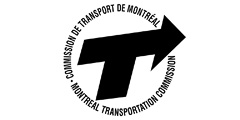
1951.06.16 Appropriation of Montreal Tramways Company assets
1955.06.27 Creation of a first express bus service on St. Denis Street
1956.09.04 Inauguration of the Frontenac garage
1957.12 Opening of the Saint-Michel garage, today’s Centre de transport adapté (paratransit)
1959.08.30 Montreal’s last tramways are pulled out of service, an event marked by a large parade
1959.12.14 First New Look buses introduced into service
1961.05.18 Ceremonies marking the centennial of public transit in Montreal
1961.10.20 The City of Montreal presents its blueprint for the métro network
1961.11.03 Montreal’s municipal council approves $132 million to build the métro
1962.02.14 Unveiling of the first modern bus shelter
1962.04.25 The first contract to build the métro is awarded to the Foundation and Charles Duranceau companies
1962.05.23 Construction of the métro’s initial network begins
1963.02.01 Establishment of public transit service in St. Leonard
1963.06.11 The City of Montreal announces the creation of the métro’s Line 4 linking Montreal to Longueuil
1963.08.06 The City of Montreal raises the budget for the métro to $213 million and awards the contract to build 369 MR-63 métro cars to Canadian Vickers
1965.08.24 Canadian Vickers delivers the first MR-63 métro cars to the City of Montreal
1965.11.27 Fare zones abolished to allow for full fare integration between bus and métro
1966.02.14 Take-over of Inter-Cité Ltée bus company activities in Rivière-des-Prairies and south sector of Cité de Jacques-Cartier
1966.04.11 Take-over of transportation services provided by Ville d’Anjou
1966.06.18 The last trolley bus retires at St. Denis garage
1966.09.26 New transit tickets are introduced prior to métro inauguration
1966.10.14 Official inauguration of the Montreal métro
1966.10.17 The métro’s arrival leads to a complete overhaul of bus services
1966.12.19 Frontenac station opens on métro’s 1 - Green line
1966.12.21 Beaudry station opens on métro’s 1 – Green line
1967.02.06 Square-Victoria station opens on métro’s 2 – Orange line
1967.02.13 Bonaventure station opens on métro’s 2 – Orange line
1967.03.31 Inauguration of métro’s 4 – Yellow line to Longueuil
1967.05.06 During Expo 67, some 418 000 visitors go through the turnstiles at Île-Sainte-Hélène station in a single day
1967.12.20 A glass panel by Frédéric Back is unveiled at Place-des-Arts métro station, the first work of art in métro’s underground gallery
1969.02.18 Removal of the last overhead cable used to power tramways and trolleybuses
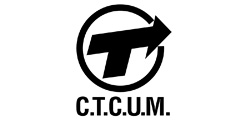
1970.01.01 The CTM becomes the Commission de transport de la Communauté urbaine de Montréal (CTCUM)
1970.09.09 The very first Origin-Destination survey is initiated
1971.02.13 New St. Denis bus garage opens
1971.03.04 During Montreal’s «storm of the century », the métro runs all night for the first time
1971.10.14 Construction of the métro extensions gets underway
1971.12.09 Fire in tail tracks section of Henri-Bourassa station
1973.01 Legendre bus garage opens
1974.01.23 Fire aboard a métro train between Laurier and Rosemont stations
1974.03.13 Blue and white colour scheme chosen for buses
1974.05.31 Bombardier wins contract to build 423 MR-73 métro cars
1974.06.25 Introduction of first Métrobus service on Newman Boulevard in LaSalle
1974.06.26 Introduction of reduced fare for persons 65 years and over
1974.11.04 The Montreal métro greets the billionth passenger in its history
1974.12.28 Payment of exact fare required aboard buses
1975.02.05 Creation of the Fire Prevention department
1975.11.30 Aéroservice begins between Mirabel and Montreal, as well as between Mirabel and Dorval airports
1976.07.02 Bombardier delivers the first MR-73 métro cars
1976.07.04 Official inauguration of stations from Préfontaine to Honoré-Beaugrand on the 1 – Green line
1976.07.23 During the Olympic Games, métro daily ridership reaches record level with 747 083 passengers
1976.11.08 Introduction of métro auto-pilot on 1 – Green line
1977.01 Launch of the «Il fait beau dans le métro» campaign
1977.09.26 Francine Maltais becomes first woman to drive a CTCUM bus
1978.09.03 Inauguration of stations from Lionel-Groulx to Angrignon on the 1 – Green line
1980.01.14 A-U-T-O-B-U-S information line begins operations
1980.04.01 Introduction of the CAM bus and métro fare card
1980.04.01 The CTCUM begins providing transportation services for the handicapped within its territory
1980.04.28 Inauguration of stations from Lucien-L’Allier to Place-Saint-Henri on the 2 – Orange line
1980.10.18 The CTCUM serves 61 of Montreal’s suburban municipalities
1980.11.10 Regular CTCUM bus service begins in Montreal’s West Island
1981.03.31 Lisette Renaud becomes the first woman to operate a métro
1981.09.09 Inauguration of stations from Vendôme to Snowdon on the 2 – Orange line
1981.12.14 Public library opens inside McGill station
1982.01.04 Côte-Sainte-Catherine station opens on the 2 – Orange line
1982.06.30 Plamondon station opens on the 2 – Orange line
1982.07.01 Trial period for permit to carry a bicycle in the métro
1982.07.01 Montréal/Deux-Montagnes commuter train line integrated into Montreal transit network
1982.10.01 Montréal/Rigaud commuter train line integrated into Montreal transit network
1983.01.03 Anjou bus garage opens
1983.02.27 First association of métro musicians
1983.05.27 First Classic bus delivered
1984.01.09 Inauguration of stations from Namur to Du Collège on the 2 – Orange line
1984.09.11 A visit by Pope John-Paul II brings ridership to 2 million people in a single day, a new record
1985.03.04 Saint-Laurent garage opens, while Charlevoix et Saint-Paul garages close down
1985.05.31 Vendôme intermodal station opens
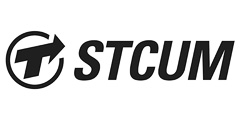
1985.06.20 The CTCUM becomes the Société de transport de la Communauté urbaine de Montréal (STCUM)
1986.06.11 Inauguration of stations from De Castelnau to Saint-Michel on the 5 – Blue line
1986.10.24 Inauguration of Côte-Vertu station on the 2 – Orange line
1987.06.09 Inauguration of Parc station on the 5 – Blue line
1987.06.11 Adoption of an equal opportunity policy (Plan d’accès à l’égalité)
1987.07.14 The « flood of the century » hits Montreal
1987.11.09 Swipe-card turnstiles undergo testing in the métro
1988.01.01 Berri-De Montigny station becomes Berri-UQAM, while Guy station becomes Guy-Concordia
1988.01.05 Inauguration of stations from Côte-des-Neiges to Outremont on the métro’s 5 – Blue line
1988.01.05 Introduction of night time bus network
1988.03.28 Acadie station opens on the 5 – Blue line
1989.10 Launch of the «Voyager en paix» campaign
1990.01.01 Introduction of a regional fare card
1990.02 First park & ride opens next to Radisson station
1990.05 Installation of maps begins in all métro stations, depicting immediate surroundings of each station
1990.06.18 Establishment of reserved lanes for buses on Pie-IX Boulevard
1990.07.09 The contract to refit the 336 MR-63 métro cars is awarded to CN’s shops (AMF)
1991.05.25 The Government of Québec withdraws from funding public transportation
1991.07.03 Electronic display system first appears inside a few métro cars
1992.03 Launch of ad campaign themed «Prendre le transport en commun, c’est intelligent»
1992.09.08 Establishment of reserved lanes for buses on Avenue du Parc, Boulevard René-Lévesque Ouest and Chemin de la Côte-des-Neiges
1992.10.08 A first multiservice centre opens at Berri-UQAM station
1992.11.09 Initial distribution of Planibus timetables in their current format
1993.04.30 STCUM begins relocating its administrative staff to Place Bonaventure
1993.08.30 Introduction of TELBUS information system
1994.08 Launch of tourist fare card, the Carte touristique
1995.01.09 LaSalle garage opens, while Namur and Saint-Henri garages close down
1995.01.27 STCUM employees and pensioners take to the streets with their Réchaud-bus for first time
1996.01.01 Administration of commuter train operations transferred to Agence métropolitaine de transport (AMT)
1996.06 Introduction of the Between Stops service (Entre deux arrêts) for women riding the bus alone in the evening
1996.12.18 First low-floor bus (APS) presented to the media
1997.04.17 Launch of the company’s Internet site
1997.06.16 Introduction of the first Trainbus lines, the 261 – Trainbus Saint-Charles and the 268 – Trainbus Pierrefonds
1998.01.05 The infamous «ice storm» hits Montreal
1998.08.24 Introduction of wheelchair-accessible bus service on three bus routes
1998.09.18 Introduction of a weekly fare card, the CAM hebdo
2000.01.01 To ring in the year 2000, buses and métro provide free service all night
2000.05.10 The STCUM decides to change the name of Île-Sainte-Hélène station to Jean-Drapeau
2001.03.01 A free daily newspaper is handed out in the métro for the first time
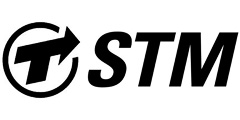
2002.01.01 The STCUM becomes the Société de transport de Montréal (STM)
2002.01.01 The reduced fare is extended to students 18 to 25 years old
2002.03.18 Construction work to extend the métro to Laval begins
2002.03.25 Launch of the Biobus project promoting the use of biodiesel
2002.04.16 Launch of the Fare Sales and Collection project, aimed at deploying a new system using smart card technology
2003.09.04 Entrance to Square-Victoria station featuring the entourage Guimard reopens
2003.09.26 Longueuil station becomes Longueuil–Université-de-Sherbrooke
2003.11.10 New A-U-T-O-B-U-S and STM-INFO telephone numbers are unveiled
2004.03.22 Launch of Phase I of the Réno-Systèmes program aimed at maintaining the reliability of the métro’s stationary equipment
2004.09.27 Métrovision’s urban television is launched in the métro
2005.03.10 Online staff recruitment is initiated
2005.06.08 Launch of Green Driving project
2005.11.18 STM announces the refitting of 423 MR-73 métro cars by its maintenance personnel
2005.12 The replacement of fare boxes aboard buses begins
2006.06.06 Pilot project for shuttle service for seniors
2007.04.26 Inauguration of Cartier, de la Concorde and Montmorency stations, in Laval, on the 2 – Orange line
2007.10.04 Inauguration of a new, underground fire prevention training centre (CFSPI)
2008.01.07 Introduction of PASTEC, a public transit service improvement program
2008.04.21 Launch of OPUS smart card
2008.04.21 Road-testing of biodiesel-electric hybrid drive buses begins
2008.04.28 Roll-out of new magnetic fare card begins
2008.12.06 Family Outings program presented to public
2009.05.07 New corporate brand image, Society in Motion, unveiled
2009.05.26 Inauguration of new bus body shop and expanded Legendre garage
2009.07.14 STM makes bus and métro schedules available by cell phone
2009.09.01 STM network only accepts electronic forms of fare payment (OPUS and magnetic fare cards)
2009.09.14 Elevators are put into service at Berri-UQAM and Lionel-Groulx stations
2009.09.30 STM’s first articulated buses are introduced into service
2010.03.10 STM social media debut with Facebook and Twitter accounts
2010.03.29 Introduction of 747 – Express bus service between downtown and Montréal-Trudeau Airport
2010.05.03 New visual identity unveiled by STM
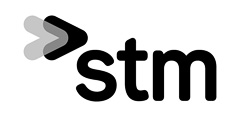
2010.08.30 Launch of 10 minutes MAX network on 31 bus routes
2010.10.05 STM wins award as Outstanding Public Transit System in North America from American Public Transportation Association (APTA)
2010.10.22 Contract to build 468 MPM-10 métro railcars awarded to Bombardier-Alstom consortium
2011.06.15 Presentation of the improved nighttime bus network
2011.10.04 The artwork La Voix lactée is given to the Paris Métro
2011.11.27 150th anniversary of public transit in Montréal
2011.12.22 STM breaks the record of 398 349 773 trips set in 1947
2012.01.09 Creation of five large clusters for bus services and renumbering of 26 bus lines
2012.03 New métro control centre becomes operational
2012.04.12 STM receives two Mercuriades awards from the Fédération des chambres de commerce du Québec (FCCQ) for raised productivity and sustainable development
2012.05.16 Unveiling of AZUR as name of new métro cars
2012.06.13 Launch of Les Étoiles du métro initiative (artists chosen through auditions)
2012.08.24 Establishment of online marketing research panel My voice, my STM
2012.09.06 Launch of iBUS project for surface transit information in real-time
2012.12.17 Creation of a first service point for the homeless at Place-des-Arts station
2013.06.04 Introduction of first interactive digital transit shelter
2013.10 First bike shelter with controlled access opens at Lionel-Groulx station
2013.11.22 Launch of City Mobility project for fully electric buses
2013.11.25 First AZUR train prototype unveiled at La Pocatière
2014.01.06 Grand opening of Stinson bus garage
2014.04.28 Delivery of first AZUR train prototype in Montréal
2014.06.12 Opening day of APTA’s international Rail Conference in Montréal
2014.08.11 Establishment of a first bus-taxi-bike reserved lane on rue Viau
2014.11.10 Square-Victoria station becomes Square-Victoria–OACI station
2014.11.26 Wireless network covers a first stretch of the métro system
2015.10.02 New signage rolled out in first métro stations
2015.10.22 Stinson bus garage is certified LEED Gold
2016.02.07 A first AZUR train begins passenger service
2016.08.19 Retirement of first MR-63 métro cars begins
2016.10.11 Announcing additional elevators for 14 more stations by 2022
2016.10.14 The Montréal métro celebrates its golden jubilee
2017.05.15 UITP World Public Transport Summit opens in Montreal
2017.05.24 Electric buses begin service as part of the Cité Mobilité project
2018.01.09 Announcement of the acquisition of 300 additional hybrid buses
2018.06.21 End of service of the original MR-63 train
2018.10.12 The inaugural métro car makes its debut at the Exporail Museum
2018.11.12 Unveiling of the Bellechasse underground transportation centre concept
2019.03.18 Construction begins on Pie-IX Bus Rapid Transit (BRT)
2019.06.13 Montréal métro becomes a national historic civil engineering site
2019.11.11 Acquisition of a first long-range electric bus
2019.11.22 Montréal buses celebrate their 100th anniversary
2020.03.12 Buses, métro and paratransit remain open during the pandemic
2020.12.03 Montréal métro is fully connected to the mobile network
2021.05.31 Opening of the new entrance building of the Vendôme multimodal hub
2021.06.22 Testing of an electric minibus for paratransit
2022.06.17 Inauguration of the Côte-Vertu underground garage for the métro
2022.10.15 Pet dogs allowed in the métro under certain conditions
2022.11.03 Inauguration of the Pie-IX BRT; service begins on November 7
2022.11.05 Call for tenders for the construction of the Blue line extension tunnel
2023.07.01 Start of free admission for Montrealers aged 65 and over
2023.07.31 The bus network is modified for the opening of the Réseau express métropolitain (REM)